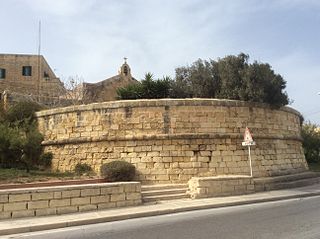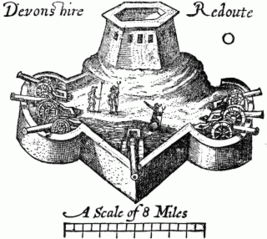
Redan is a feature of fortifications. It is a work in a V-shaped salient angle towards an expected attack. It can be made from earthworks or other material.

A blockhouse is a small fortification, usually consisting of one or more rooms with loopholes, allowing its defenders to fire in various directions. It is usually an isolated fort in the form of a single building, serving as a defensive strong point against any enemy that does not possess siege equipment or, in modern times, artillery, air force or cruise missiles. A fortification intended to resist these weapons is more likely to qualify as a fortress or a redoubt, or in modern times, be an underground bunker. However, a blockhouse may also refer to a room within a larger fortification, usually a battery or redoubt.

Fort San Lucian, also known as Saint Lucian Tower or Fort Rohan, is a large bastioned watchtower and polygonal fort in Marsaxlokk, Malta. The original tower was built by the Order of Saint John between 1610 and 1611, being the second of six Wignacourt towers.
Marsalforn Tower refers to two towers that stood near Marsalforn, in the limits of Xagħra, Gozo, Malta. The first one was built in 1616, as the fourth of six Wignacourt towers, and collapsed around 1715. The second was a Tour-reduit, which was built in 1720 and demolished in 1915.

Fort Tigné is a polygonal fort in Tigné Point, Sliema, Malta. It was built by the Order of Saint John between 1793 and 1795 to protect the entrance to Marsamxett Harbour. It is one of the oldest polygonal forts in the world. The fort, extensively altered by the British in the 19th century, remained in use by the military until 1979.

The fortifications of Malta consist of a number of walled cities, citadels, forts, towers, batteries, redoubts, entrenchments and pillboxes. The fortifications were built over hundreds of years, from around 1450 BC to the mid-20th century, and they are a result of the Maltese islands' strategic position and natural harbours, which have made them very desirable for various powers.

San Rocco Battery was an artillery battery in Kalkara, Malta, built by Maltese insurgents during the French blockade of 1798–1800. It was the last in a chain of batteries, redoubts and entrenchments encircling the French positions in Marsamxett and the Grand Harbour. It was built to control the entrance to the harbour as well as the French occupied Fort Ricasoli. The battery was continually being fired upon by the French at Fort Ricasoli, which was located about 700 m (2,300 ft) away.

San Rocco Redoubt was a redoubt in Kalkara, Malta. It was built by Great Britain during the French blockade of 1798-1800. It was part of a chain of batteries, redoubts and entrenchments encircling the French positions in Marsamxett and the Grand Harbour.

Vendôme Tower is a tour-reduit in Marsaxlokk, Malta. It was built by the Order of Saint John in 1715 as one of a series of fortifications around the coasts of the Maltese Islands. It is the only surviving tour-reduit in Malta. Today, Vendôme Tower houses the headquarters of Marsaxlokk F.C.

Westreme Battery, also known as ir-Rasus Battery or Mellieħa Right Battery, is a former artillery battery in Mellieħa, Malta. It was built by the Order of Saint John in 1715–1716 as one of a series of coastal fortifications around the Maltese Islands.

Ferretti Battery, also known as Qajjenza Battery or Saint George's Battery, is an artillery battery in the village of Qajjenza, within the limits of Birżebbuġa, in Malta. It was built by the Order of Saint John in 1715 and 1716 as one of a series of fortifications around the coasts of the Maltese Islands. A restaurant exists within the walls of the battery, serving Mediterranean cuisine.

Vendôme Battery, also known as Ta' Maċċu Battery, is an artillery battery near Armier Bay, limits of Mellieħa, Malta. It was built by the Order of Saint John in 1715–1716 as one of a series of coastal fortifications around the Maltese Islands.
Fedeau Battery was an artillery battery in Mellieħa, Malta. It was built by the Order of Saint John in 1714-16 as part of a series of coastal fortifications around the Maltese Islands, and demolished in the 20th century.

Pinto Battery, also known as Għżira Battery or Kechakara Battery, is a former artillery battery in Birżebbuġa, Malta. It was built by the Order of Saint John in 1715 and 1716 as one of a series of coastal fortifications around the coasts of the Maltese Islands. The battery has been heavily altered over time, and the blockhouse now houses a bar and a garage, while the gun platform and parapet have been largely destroyed, with only the general outline still visible.

Saint George Redoubt is a redoubt in Birżebbuġa, Malta. It was built in 1714–1716 by the Order of Saint John as one of a series of coastal fortifications around the Maltese Islands. It is named after a chapel dedicated to St. George, which was incorporated within the redoubt. The redoubt and chapel still exist and are in good condition.
Del Fango Redoubt, also known as De Vami Redoubt, was a redoubt in Marsaxlokk, Malta. Made of limestone, it was built in 1715–1716 by the Order of Saint John as part of a series of coastal fortifications around the Maltese Islands. An entrenchment was originally located close to the redoubt.
Spinola Redoubt, also known as Birżebbuġa Redoubt, was a tour-reduit in Birżebbuġa, Malta. It was built by the Order of Saint John in 1715–1716 as one of a series of coastal fortifications around the Maltese Islands. It has been demolished.
Fresnoy Redoubt, also known as Kalafrana Redoubt, was a tour-reduit in Birżebbuġa, Malta. It was built by the Order of Saint John in 1715–1716 as one of a series of coastal fortifications around the Maltese Islands. It was demolished in 1897.
Balbani Battery, also known as Bengħisa Battery or Saint Catherine's Battery, was an artillery battery in Birżebbuġa, Malta. It was built by the Order of Saint John on commands by Grand Master Manuel Pinto da Fonseca and was completed in 1721. The battery was named for Cristoforo Balbani, who partially financed its construction. It was one of a series of coastal fortifications around the Maltese Islands.
Elminiech Battery, also known as Figuella Battery, San Raimondo Battery or Oitelboura Battery, was an artillery battery in Birżebbuġa, Malta. It was built by the Order of Saint John in 1715–16 as part of a series of coastal fortifications around the Maltese Islands.















